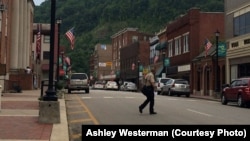The Appalachian Mountain region of the United States is not typically a place one would go in search of racial diversity. The U.S. Census Bureau says racial minorities made up less than 10 percent of the 25 million people in the region.
But the growth of the health care industry in some parts of Appalachia is creating pockets of diversity. In Hazard, Kentucky, even though whites make up 90 percent of the population, the town is embracing diversity.
Hazard is known as “The Pear of the Mountains” and, with its population of about 5,000, sits nestled in the hills of eastern Kentucky. Its newly expanded hospital is bustling with life. Built in 1987, the Hazard Regional Medical Center is one of 10 hospitals in the Appalachian Regional Health Care network.
Cardiologist Vidya Yalamanchi has lived and worked in the Hazard area since the late 1980s. Born in a small town in India, Yalamanchi's first stop in the United States was Chicago, where he said the hardest part was not the internal medicine training, residency and cardiology fellowship, it was the food.
“I am used to spicy food and here it is very bland.," he said. "And you have to go to the fast food and you can not get a lot of vegetarian food. Food was a bit of a problem.”
When Yalamanchi and his wife eventually moved to Hazard, culture shock came in a different form. Yalamanchi said the first time he came into a patient's room, there were 13 family members waiting for him.
“So it was a big shock to me to see that many people for one patient," he said. "In Chicago we hardly see one or two people, they come in the evening and that is it.”
And those people turned into big, thankful families.
When he arrived, Yalamanchi was only one of three specialty doctors in the area and his cardiology department did not have the ability to do Coronary Artery Disease screenings - CAD tests. They would have to transfer patients almost two hours away to Lexington. Since then, the department gained two more doctors and they now perform CAD tests and by-pass surgery.
Yalamanchi thinks improving access to health care, especially specialized health care, is why ethnic doctors have been so accepted in Hazard.
“A lot of people like me and I like them, and I enjoy seeing them," said Yalamanchi. "So I did not have any problem ethnicity wise. I think a lot of foreign physicians are really accepted in the community.”
Sentiments of townspeople on Hazard's Main Street match Dr. Yalamanchi's open and welcoming description.
Coal miner Grant Baker is glad to see more cultural diversity in the area and even happier to see the new hospital. Baker said more diversity means more jobs, and even though the coal industry may be down, Hazard is thriving.
“Hazard has gotten a lot bigger," Baker said. "A new bridge, a new court house, a new post office, a new everything and it is stretching out, stretching out, you know.”
Hazard native, 29-year-old Jen Noble owns the Treehouse Café and Bakery and is part of a group of locals promoting cultural diversity.
“We do monthly poet series, we have local musicians that come in, we have local art work, and we have all natural food so it is something different than what we have had in Hazard before,” she said.
“Always open to something different” is a good way to describe Hazard, said Martha Quigley, the director of the Bobby Davis Museum and Park.
Like many places in the U.S. south, Quigley said Hazard has had its run-ins with racism. She said slavery was alive and well in the 19th century and the town struggled, like many did, with integration in the 1960s.
Hate crimes and racism still occur in Kentucky’s Appalachian region. In 2012, two Harlan County men were accused of assaulting a gay man, although they were eventually acquitted. And the Ku Klux Klan, one of America’s oldest hate groups, is still active.
As for Hazard today, Quigley said neighborhoods are more integrated and people from all walks of life get along pretty well together. She attributes this, in part, to the influx of doctors brought to the area in the 1970s to address a shortage.
“A lot of doctors were recruited from India of all places," she said. "And many of them, after they completed their contracts, they decided to stay.”
Dr. Yalamanchi's favorite part about living in Hazard is the people. He said there are physicians from places like Lebanon, the Philippines and Syria - and they are all very well accepted.
“Basically they want good service, quality service. If you provide for them, take good care of them, they really appreciate," he said. "And we are really accepted, no problem.”
This story was funded by the Hearst Foundations and administered by the International Center for Journalists in Washington, DC.






